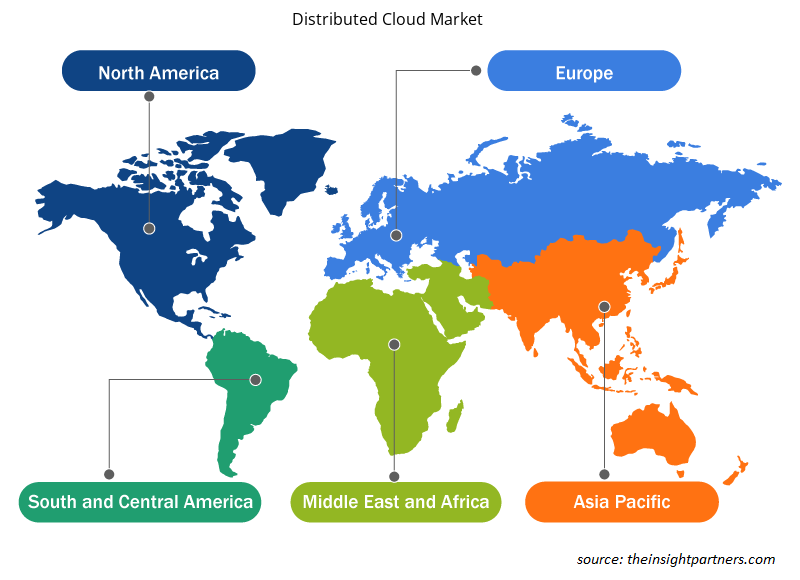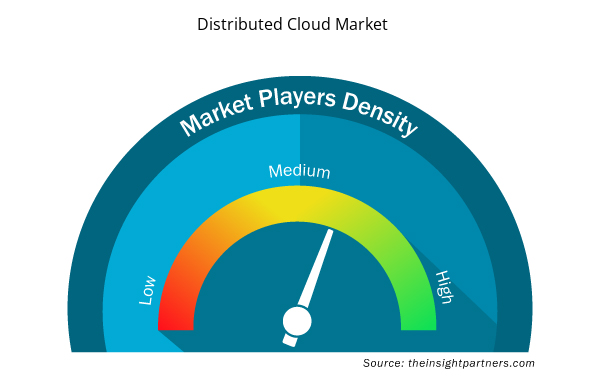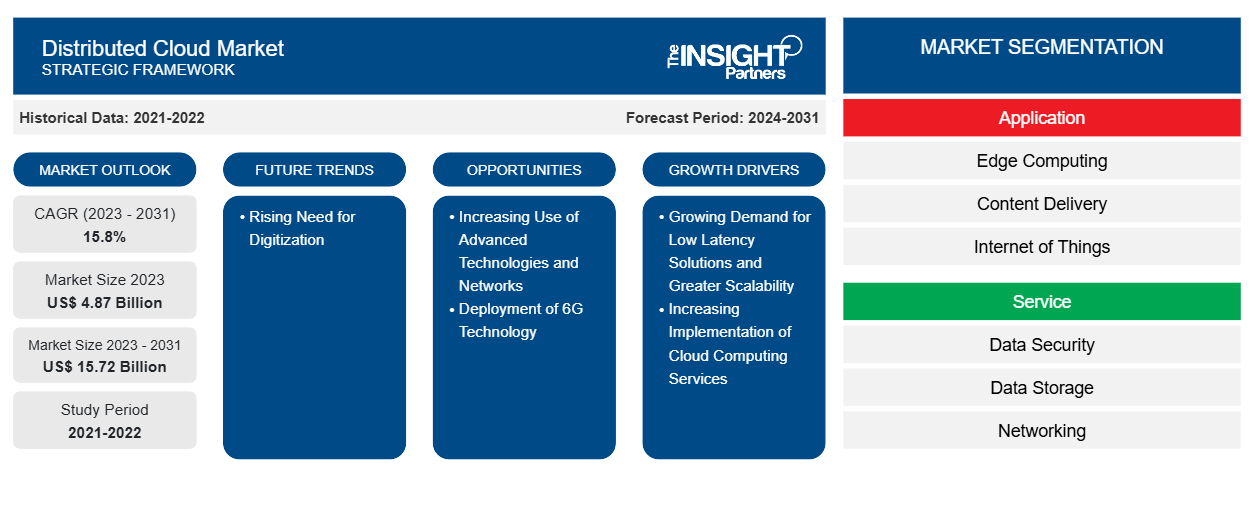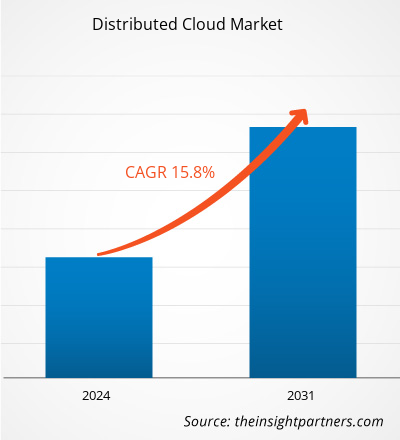分散型クラウドの市場規模は、2023 年の 48.7 億米ドルから 2031 年には 157.2 億米ドルに達すると予測されています。市場は2023 年から 2031 年にかけて 15.8% のCAGR を記録すると予想されています。デジタル化のニーズが高まることで、市場に新たなトレンドが生まれる可能性が高くなります。
分散クラウド市場分析
分散型クラウド市場の成長は、低遅延ソリューションと拡張性の向上に対する需要の高まりに起因しています。分散型クラウド コンピューティングは、処理タスクをエンド ユーザーの近くに再配置することで、サービスの応答性も向上させます。さらに、自動車、教育、金融、小売、不動産、農業、メディア、エンターテイメントなど、いくつかの業界でクラウド コンピューティング サービスの実装が増加していることも、市場を牽引しています。さらに、デジタル化と 6G テクノロジの導入に対する要件の高まりにより、今後数年間で分散型クラウド市場が活性化すると予想されています。アジア太平洋地域では、クラウド コンピューティングの成長と投資が著しく増加しており、パブリック クラウド サービスの収益も増加すると予想されています。中国は、この地域で最大のパブリック クラウド市場として認識されています。Alibaba Cloud や Huawei などのトップクラスのインフラストラクチャ サービス ( IaaS ) 企業は、中国に拠点を置いています。さらに、アジア太平洋地域の政府は、地政学的な混乱、サイバー脅威の増大、データ保護法の変更、デジタル貿易政策の変化により、主権クラウド ソリューションにますます関心を示しています。
分散クラウド市場の概要
分散クラウドのアーキテクチャには、コンプライアンス要件とパフォーマンス ニーズを満たすのに役立つ複数のクラウドが含まれ、パブリック クラウド プロバイダーによって集中管理されながらエッジ コンピューティングをサポートします。モノのインターネット ( IoT ) とエッジ コンピューティングの成長は、分散クラウドの導入を推進する大きな要因となっています。大量のデータをエッジ ロケーションからクラウドに移動する人工知能 (AI) アプリケーションでは、クラウド サービスがエッジ ロケーションにできるだけ近いことが必要です。また、クラウド リソースをエッジ ロケーション自体に移動すると、これらのアプリケーションのパフォーマンスが大幅に向上します。
要件に合わせてレポートをカスタマイズする
このレポートの一部、国レベルの分析、Excelデータパックなど、あらゆるレポートを無料でカスタマイズできます。また、スタートアップや大学向けのお得なオファーや割引もご利用いただけます。
- このレポートの主要な市場動向を入手してください。この無料サンプルには、市場動向から見積もりや予測に至るまでのデータ分析が含まれます。
分散クラウド市場の推進要因と機会
低遅延ソリューションと拡張性の向上に対する需要の高まりが市場を有利に導く
低レイテンシとは、最小限の遅延時間で大量のデータ メッセージを処理できるように改善されたコンピュータ ネットワークです。これらのネットワークは、急速に変化するデータへのほぼリアルタイムのアクセスを必要とする機能をサポートすることを目的としています。分散クラウド コンピューティングは、処理タスクをエンド ユーザーの近くに再配置することで、レイテンシを短縮し、サービスの応答性を高めます。その後、データは集中サーバーではなくローカルで管理され、優れたユーザー エクスペリエンスが実現します。さらに、さまざまな企業が低レイテンシのニーズを満たすために分散クラウド サービスを提供しました。たとえば、2023 年 9 月、Oracle は分散クラウド サービスを拡大し、組織の多様なニーズと Oracle Cloud Infrastructure ( OCI ) サービスに対する世界的な需要の高まりに対応しました。Oracle Database Azure と AWS 上の MySQL HeatWave Lakehouse は、 OCI の分散クラウドに新たに追加されたものです。その結果、企業は、データ プライバシー、データ主権、低レイテンシの多数の要件に対応しながら、どこにでもクラウド サービスを展開できる柔軟性が向上し、あらゆるワークロードを実行するように設計された 100 を超えるサービスにアクセスできるようになります。
6G技術の導入
6Gは、マイクロ秒単位のレイテンシを提供することが認められています。これにより、分散クラウドサービスは、拡張現実(AR)、仮想現実(VR )、自動運転などのリアルタイム処理タスクを前例のない効率で実行できます。さまざまな企業が6G分散クラウドおよび通信システムを提供しています。たとえば、Next G Alliance(NGA)は、分散クラウドおよび通信システムを提供しています。NGAは、北米の6Gビジョンのためにこのシステムを開発しました。6Gシステムを、デバイス、データセンター、ネットワークノード全体に豊富なコンピューティングとワークロード分散を備えた広域クラウドにすることを目的としています。6G分散クラウドおよび通信システムは、ネットワークのクラウド化とエッジコンピューティングに関する4Gおよび5Gでは達成されていない、通信とコンピューティングのシステム機能を結合するための一歩です。したがって、6Gテクノロジーの展開は、予測期間中に分散クラウド市場の成長にいくつかの機会をもたらすと予想されます。
分散クラウド市場レポートのセグメンテーション分析
分散クラウド市場分析の導出に貢献した主要なセグメントは、アプリケーション、サービス、エンタープライズ、規模、および業界垂直です。
- アプリケーションに基づいて、分散クラウド市場はエッジコンピューティング、コンテンツ配信、モノのインターネットなどに分かれています。エッジコンピューティングセグメントは、2023年に最大の市場シェアを占めました。エッジコンピューティングは、エンタープライズアプリケーションをローカルエッジサーバーやIoTデバイスなどのデータソースに近づける分散コンピューティングの概要です。これにより、応答時間が改善され、洞察が速くなり、帯域幅の可用性が向上します。
- サービス別に見ると、市場はデータ セキュリティ、データ ストレージ、ネットワーク、その他に分類されます。2023 年には、データ ストレージ セグメントが最大の市場シェアを占めました。データ ストレージ サービスには、さまざまなクラウド環境にわたってデータを安全に保存および管理するための対策の実装が含まれます。これには、データの可用性の確保、データの制御の喪失、堅牢なデータ バックアップおよびリカバリ戦略の必要性などの懸念への対処が含まれます。
- 企業規模の観点から見ると、市場は大企業と中小企業に分かれています。大企業セグメントは2023年に市場の大きなシェアを占めました。大手企業は、分散コンピューティングモデルを利用して、ビジネスプロセスのさまざまな段階をコンピューターネットワーク全体に効果的に分散します。これは通常、プレゼンテーション、アプリケーション、およびデータレイヤーに構造化されています。大企業は、マルチクラウド戦略を採用する傾向が高まっており、コンピューティングニーズを複数のクラウドプロバイダーに分散して、単一のベンダーに縛られることを回避し、回復力を強化しています。
- 分散型クラウド市場は、業種別に見ると、BFSI、医療、小売・電子商取引、製造、IT・通信、エネルギー・公共事業、メディア・エンターテインメント、政府・防衛、その他に分類されます。BFSI業界は、重要な課題に取り組み、イノベーションを促進するために、分散型クラウド テクノロジーの可能性をますます活用しています。この業界は、迫りくるサイバー攻撃の脅威、データの整合性を維持しながら顧客データの収集を合理化する必要性、厳格なセキュリティ標準と規制を遵守するという差し迫った必要性に常に直面しています。
地域別の分散クラウド市場シェア分析
分散クラウド市場レポートの地理的範囲は、主に北米、アジア太平洋、ヨーロッパ、中東およびアフリカ、南米および中米の 5 つの地域に分かれています。
北米では、クラウド イネーブルメント活動の増加とクラウド市場内のトレンドにより、分散型クラウド市場の大幅な成長が見込まれています。分散型クラウドにより、企業は追加料金なしであらゆるサイズのデータを転送でき、一般データ保護規則 (GDPR) に準拠しながらデータ主権を確保できます。AI を搭載したデータ レイクが提供され、データを一元化して予測分析の品質が向上します。製造、IoT、機械学習、イメージングなど、さまざまなシナリオで使用できます。
ヨーロッパの分散型クラウド コンピューティング セクターは、さまざまなテクノロジーと規制の組み合わせによって定義されています。クラウド テクノロジーは拡大しており、EU 諸国全体でさまざまなクラウド テクノロジーが採用されています。EU は、エッジへの移行を可能にし、互換性のあるクラウド サービスとエッジ サービスを作成して、統一されたヨーロッパのデータ スペースの確立を支援するために、注目すべき取り組みを行っています。さらに、クラウド サービス向けの欧州サイバー セキュリティ認証スキーム (EUCS) などの手段により、特に規制対象セクターで、データ レジデンシーの保証、運用スタッフの管理、管轄権の課題の影響の最小化に重点が置かれています。
分散クラウド市場の地域別分析
予測期間を通じて分散クラウド市場に影響を与える地域的な傾向と要因は、Insight Partners のアナリストによって徹底的に説明されています。このセクションでは、北米、ヨーロッパ、アジア太平洋、中東およびアフリカ、南米および中米にわたる分散クラウド市場のセグメントと地理についても説明します。

- 分散クラウド市場の地域別データを入手
分散クラウド市場レポートの範囲
| レポート属性 | 詳細 |
|---|---|
| 2023年の市場規模 | 48億7千万米ドル |
| 2031年までの市場規模 | 157.2億米ドル |
| 世界のCAGR(2023年~2031年) | 15.8% |
| 履歴データ | 2021-2022 |
| 予測期間 | 2024-2031 |
| 対象セグメント | アプリケーション別
|
| 対象地域と国 | 北米
|
| 市場リーダーと主要企業プロフィール |
|
分散クラウド市場のプレーヤー密度: ビジネスダイナミクスへの影響を理解する
分散クラウド市場は、消費者の嗜好の変化、技術の進歩、製品の利点に対する認識の高まりなどの要因により、エンドユーザーの需要が高まり、急速に成長しています。需要が高まるにつれて、企業は提供内容を拡大し、消費者のニーズを満たすために革新を起こし、新たなトレンドを活用し、市場の成長をさらに促進しています。
市場プレーヤー密度とは、特定の市場または業界内で活動している企業または会社の分布を指します。これは、特定の市場スペースに、その市場規模または総市場価値に対してどれだけの競合相手 (市場プレーヤー) が存在するかを示します。
分散クラウド市場で事業を展開している主要企業は次のとおりです。
- アリババクラウド Cloud
- Amazon Web Services, Inc.
- グーグル
- IBM
- オラクル
- マイクロソフト
免責事項:上記の企業は、特定の順序でランク付けされていません。

- 分散クラウド市場の主要なプレーヤーの概要を入手
分散クラウド市場のニュースと最近の動向
分散型クラウド市場は、主要な企業出版物、協会データ、データベースなどの一次調査と二次調査後の定性的および定量的データを収集することによって評価されます。分散型クラウド市場の動向のいくつかを以下に示します。
- Cloud Software Group Inc. と Microsoft Corp. は、8 年間の戦略的パートナーシップ契約を通じて協力関係を深めることを発表しました。この契約により、Citrix® 仮想アプリケーションおよびデスクトップ プラットフォームの市場投入コラボレーションが強化され、統合された製品ロードマップによる新しいクラウドおよび AI ソリューションの開発がサポートされます。さらに、Cloud Software Group は、Microsoft クラウドとその生成 AI 機能に 16 億 5,000 万ドルを投資します。
(出典: Microsoft、企業ウェブサイト、2024 年 4 月)
- Oracle、Microsoft、OpenAl は提携して、Microsoft Azure Al プラットフォームを Oracle Cloud Infrastructure (OCI) に拡張し、OpenAl に追加の容量を提供します。OCI の専用 AI 機能により、スタートアップ企業や企業は、Oracle の分散クラウドのどこからでも、より迅速かつ確実にモデルを構築およびトレーニングできます。
(出典:Oracle、企業ウェブサイト、2024年6月)
分散クラウド市場レポートの対象範囲と成果物
「分散クラウド市場の規模と予測(2021〜2031年)」レポートでは、以下の分野をカバーする市場の詳細な分析を提供しています。
- 対象範囲に含まれるすべての主要市場セグメントについて、世界、地域、国レベルでの分散クラウド市場規模と予測
- 分散クラウド市場の動向と、推進要因、制約、主要な機会などの市場動向
- 詳細なPEST/ポーターの5つの力とSWOT分析
- 主要な市場動向、世界および地域の枠組み、主要プレーヤー、規制、最近の市場動向を網羅した分散クラウド市場分析
- 市場集中、ヒートマップ分析、主要プレーヤー、分散クラウド市場の最近の動向を網羅した業界の状況と競争分析
- 詳細な企業プロフィール
- 過去2年間の分析、基準年、CAGRによる予測(7年間)
- PEST分析とSWOT分析
- 市場規模価値/数量 - 世界、地域、国
- 業界と競争環境
- Excel データセット



Report Coverage
Revenue forecast, Company Analysis, Industry landscape, Growth factors, and Trends

Segment Covered
This text is related
to segments covered.

Regional Scope
North America, Europe, Asia Pacific, Middle East & Africa, South & Central America

Country Scope
This text is related
to country scope.
よくある質問
Rising need for digitization is expected to present new trends in the market during the forecast period.
The market is anticipated to expand at a CAGR of 15.8% during 2023–2031.
Oracle, Amazon Web Services, Inc., IBM, Broadcom, and Google are major players in the market.
The market is projected to reach US$ 15.72 billion by 2031.
North America dominated the distributed cloud market in 2023.
Increasing demand for low latency solutions and greater scalability and increasing implementation of cloud computing services in several industries are driving the market growth.
Trends and growth analysis reports related to Technology, Media and Telecommunications : READ MORE..
The List of Companies - Distributed Cloud Market
- Alibaba Cloud
- Amazon Web Services, Inc.
- IBM
- Oracle
- Microsoft
- RACKSPACE TECHNOLOGY
- Broadcom
- Databricks
- Salesforce, Inc.
The Insight Partners performs research in 4 major stages: Data Collection & Secondary Research, Primary Research, Data Analysis and Data Triangulation & Final Review.
- Data Collection and Secondary Research:
As a market research and consulting firm operating from a decade, we have published and advised several client across the globe. First step for any study will start with an assessment of currently available data and insights from existing reports. Further, historical and current market information is collected from Investor Presentations, Annual Reports, SEC Filings, etc., and other information related to company’s performance and market positioning are gathered from Paid Databases (Factiva, Hoovers, and Reuters) and various other publications available in public domain.
Several associations trade associates, technical forums, institutes, societies and organization are accessed to gain technical as well as market related insights through their publications such as research papers, blogs and press releases related to the studies are referred to get cues about the market. Further, white papers, journals, magazines, and other news articles published in last 3 years are scrutinized and analyzed to understand the current market trends.
- Primary Research:
The primarily interview analysis comprise of data obtained from industry participants interview and answers to survey questions gathered by in-house primary team.
For primary research, interviews are conducted with industry experts/CEOs/Marketing Managers/VPs/Subject Matter Experts from both demand and supply side to get a 360-degree view of the market. The primary team conducts several interviews based on the complexity of the markets to understand the various market trends and dynamics which makes research more credible and precise.
A typical research interview fulfils the following functions:
- Provides first-hand information on the market size, market trends, growth trends, competitive landscape, and outlook
- Validates and strengthens in-house secondary research findings
- Develops the analysis team’s expertise and market understanding
Primary research involves email interactions and telephone interviews for each market, category, segment, and sub-segment across geographies. The participants who typically take part in such a process include, but are not limited to:
- Industry participants: VPs, business development managers, market intelligence managers and national sales managers
- Outside experts: Valuation experts, research analysts and key opinion leaders specializing in the electronics and semiconductor industry.
Below is the breakup of our primary respondents by company, designation, and region:

Once we receive the confirmation from primary research sources or primary respondents, we finalize the base year market estimation and forecast the data as per the macroeconomic and microeconomic factors assessed during data collection.
- Data Analysis:
Once data is validated through both secondary as well as primary respondents, we finalize the market estimations by hypothesis formulation and factor analysis at regional and country level.
- Macro-Economic Factor Analysis:
We analyse macroeconomic indicators such the gross domestic product (GDP), increase in the demand for goods and services across industries, technological advancement, regional economic growth, governmental policies, the influence of COVID-19, PEST analysis, and other aspects. This analysis aids in setting benchmarks for various nations/regions and approximating market splits. Additionally, the general trend of the aforementioned components aid in determining the market's development possibilities.
- Country Level Data:
Various factors that are especially aligned to the country are taken into account to determine the market size for a certain area and country, including the presence of vendors, such as headquarters and offices, the country's GDP, demand patterns, and industry growth. To comprehend the market dynamics for the nation, a number of growth variables, inhibitors, application areas, and current market trends are researched. The aforementioned elements aid in determining the country's overall market's growth potential.
- Company Profile:
The “Table of Contents” is formulated by listing and analyzing more than 25 - 30 companies operating in the market ecosystem across geographies. However, we profile only 10 companies as a standard practice in our syndicate reports. These 10 companies comprise leading, emerging, and regional players. Nonetheless, our analysis is not restricted to the 10 listed companies, we also analyze other companies present in the market to develop a holistic view and understand the prevailing trends. The “Company Profiles” section in the report covers key facts, business description, products & services, financial information, SWOT analysis, and key developments. The financial information presented is extracted from the annual reports and official documents of the publicly listed companies. Upon collecting the information for the sections of respective companies, we verify them via various primary sources and then compile the data in respective company profiles. The company level information helps us in deriving the base number as well as in forecasting the market size.
- Developing Base Number:
Aggregation of sales statistics (2020-2022) and macro-economic factor, and other secondary and primary research insights are utilized to arrive at base number and related market shares for 2022. The data gaps are identified in this step and relevant market data is analyzed, collected from paid primary interviews or databases. On finalizing the base year market size, forecasts are developed on the basis of macro-economic, industry and market growth factors and company level analysis.
- Data Triangulation and Final Review:
The market findings and base year market size calculations are validated from supply as well as demand side. Demand side validations are based on macro-economic factor analysis and benchmarks for respective regions and countries. In case of supply side validations, revenues of major companies are estimated (in case not available) based on industry benchmark, approximate number of employees, product portfolio, and primary interviews revenues are gathered. Further revenue from target product/service segment is assessed to avoid overshooting of market statistics. In case of heavy deviations between supply and demand side values, all thes steps are repeated to achieve synchronization.
We follow an iterative model, wherein we share our research findings with Subject Matter Experts (SME’s) and Key Opinion Leaders (KOLs) until consensus view of the market is not formulated – this model negates any drastic deviation in the opinions of experts. Only validated and universally acceptable research findings are quoted in our reports.
We have important check points that we use to validate our research findings – which we call – data triangulation, where we validate the information, we generate from secondary sources with primary interviews and then we re-validate with our internal data bases and Subject matter experts. This comprehensive model enables us to deliver high quality, reliable data in shortest possible time.


 このレポートの無料サンプルを入手する
このレポートの無料サンプルを入手する